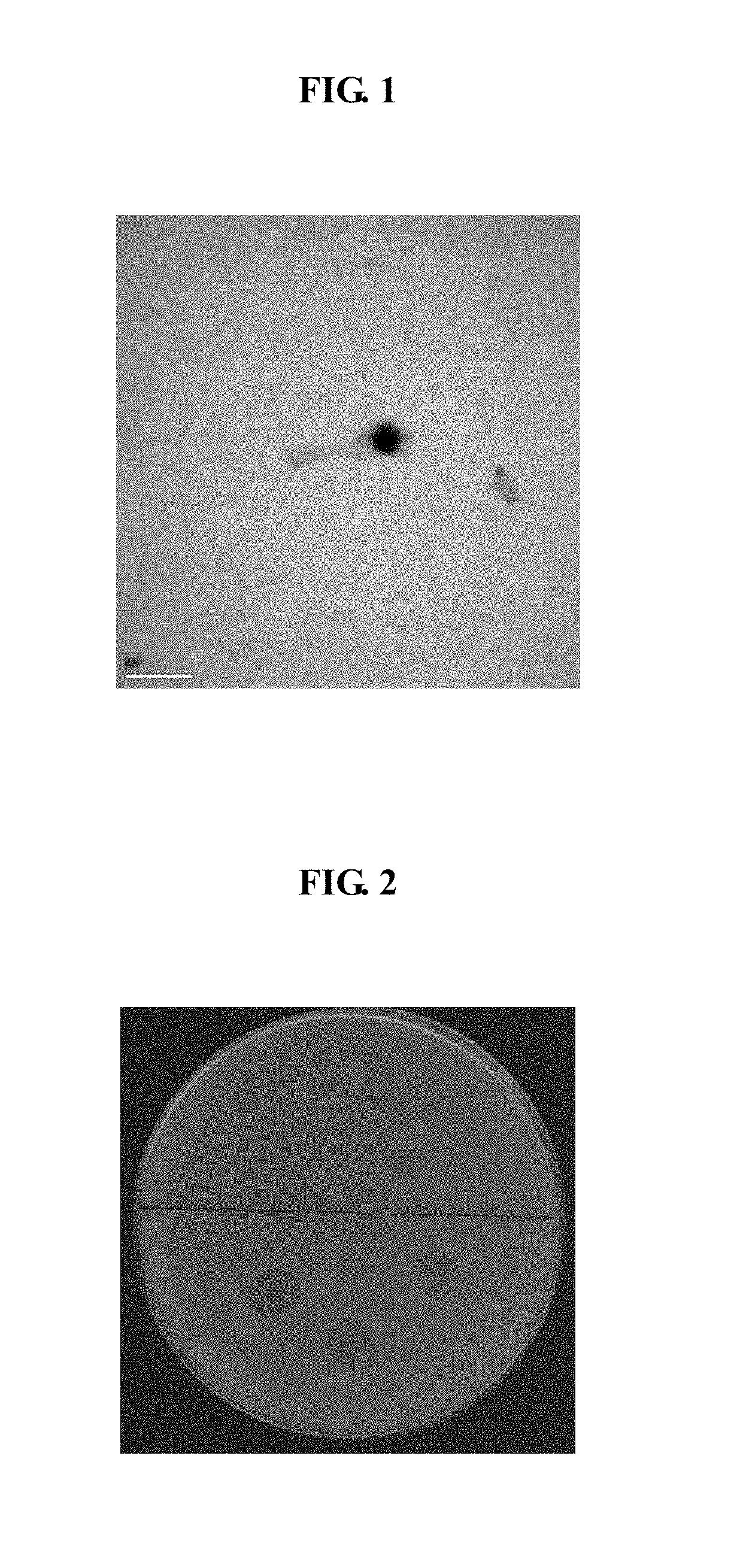Novel enteropathogenic e. coli bacteriophage esc-chp-2 and use thereof for inhibiting proliferation of enteropathogenic e. coli
a technology of enteropathogenic e. coli and bacteriophage escchp-2, which is applied in the direction of antibacterial agents, biological water/sewage treatment, dispersed delivery, etc., can solve the problems of limited bacterium that can be infected by certain bacteriophage, large economic loss, etc., and achieves fewer side effects and high specificity to enteropathogenicity
- Summary
- Abstract
- Description
- Claims
- Application Information
AI Technical Summary
Benefits of technology
Problems solved by technology
Method used
Image
Examples
example 2
n and Sequence Analysis of the Bacteriophage Esc-CHP-2 Genome
[0037]The genome of the bacteriophage Esc-CHP-2 was separated as follows. The genome was separated from the bacteriophage suspension obtained in Example 1. First, in order to eliminate DNA and RNA of enteropathogenic E. coli included in the suspension, DNase I and RNase A were added 200 U each to 10 ml of the bacteriophage suspension, which was incubated at 37° C. for 30 minutes. 30 minutes later, to remove the DNase I and RNase A activity, 500 μl of 0.5 M ethylenediaminetetraacetic acid (EDTA) was added thereto, which was incubated for 10 minutes. The suspension was further incubated at 65° C. for 10 minutes and then added with 100 μl of proteinase K (20 mg / ml) to break the outer wall of the bacteriophage, followed by incubation at 37° C. for 20 minutes. After that, 500 μl of 10% sodium dodecyl sulfate (SDS) solution was added thereto, followed by incubation at 65° C. for 1 hour. 10 ml of the mixture of phenol:chloroform:...
example 6
on of Feed Additives and Feeds
[0047]Feed additive containing bacteriophage Esc-CHP-2 at a concentration of 1×108 pfu / g was prepared using the bacteriophage Esc-CHP-2 solution. The preparation method thereof was as follows: Maltodextrin (40%, w / v) was added to the bacteriophage solution and then, trehalose was added to reach 10% of final concentration. After mixing well, the mixture was freeze-dried. Lastly, the dried mixture was grinded into fine powders. The drying process above can be replaced with vacuum-drying, drying at warm temperature, or drying at room temperature. To prepare the control feed additive for comparison, feed additive that did not contain the bacteriophage but contained buffer (10 mM Tris-HCl, 10 mM MgSO4, 0.1% Gelatin, pH 8.0) only was prepared.
[0048]The above two kinds of feed additives were mixed with the 1,000 times volume of feed for pig farming respectively, resulting in two kinds of final feeds.
example 7
on of Drinking Water Additives and Disinfectants
[0049]Drinking water additive and disinfectant are different in intended use but same in the composition, so they have been prepared by the same manner. Drinking water additive (or disinfectant) containing bacteriophage Esc-CHP-2 at a concentration of ix 108 pfu / ml was prepared using the bacteriophage Esc-CHP-2 solution. Particularly, to prepare drinking water additive (or disinfectant), the bacteriophage ESC-CHP-2 solution was added to buffer solution to reach 1×108 pfu / ml, which was mixed well. For the comparison, the above buffer solution itself was used as the drinking water additive (or disinfectant) that did not contain the bacteriophage.
[0050]The prepared two kinds of drinking water additives (or disinfectants) were diluted in water at the ratio of 1:1000, and then used as drinking water or disinfectant.
PUM
| Property | Measurement | Unit |
|---|---|---|
| pH | aaaaa | aaaaa |
| volume | aaaaa | aaaaa |
| pH | aaaaa | aaaaa |
Abstract
Description
Claims
Application Information
 Login to view more
Login to view more - R&D Engineer
- R&D Manager
- IP Professional
- Industry Leading Data Capabilities
- Powerful AI technology
- Patent DNA Extraction
Browse by: Latest US Patents, China's latest patents, Technical Efficacy Thesaurus, Application Domain, Technology Topic.
© 2024 PatSnap. All rights reserved.Legal|Privacy policy|Modern Slavery Act Transparency Statement|Sitemap


